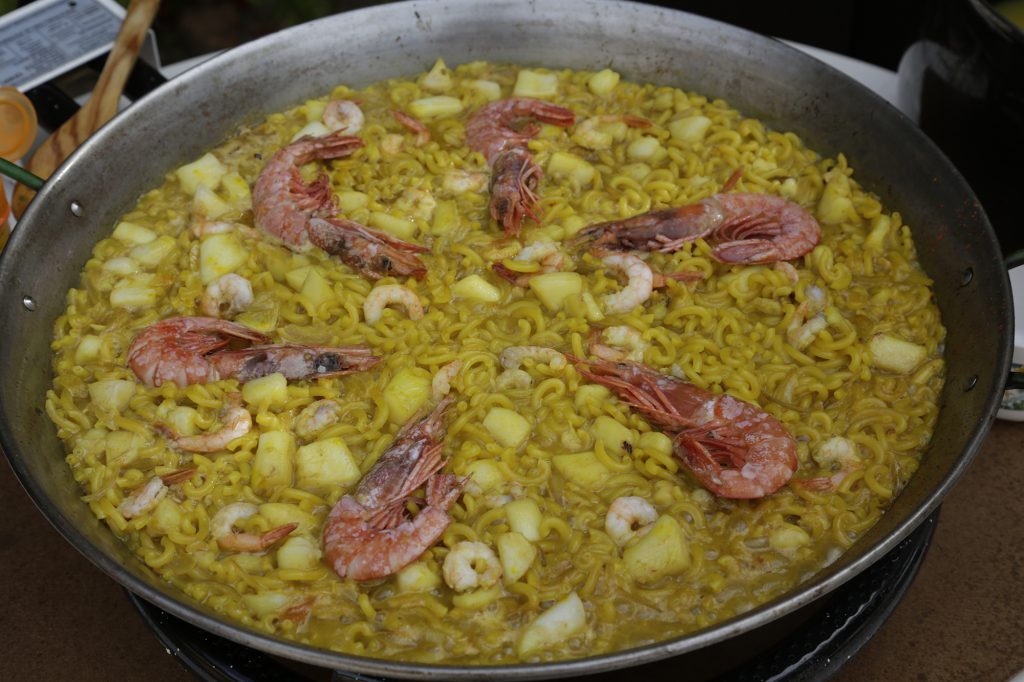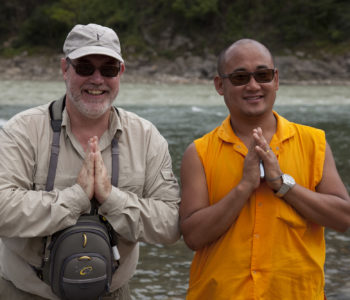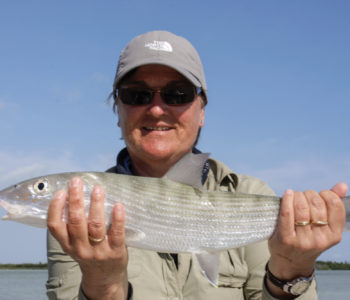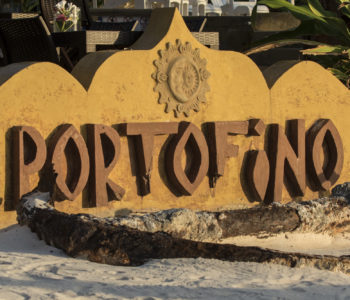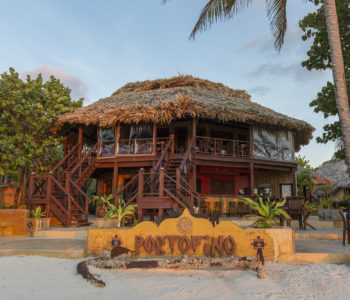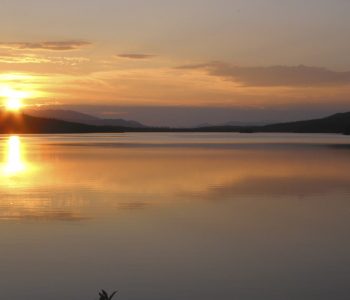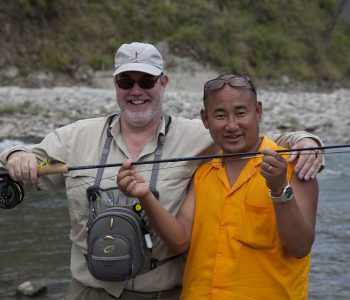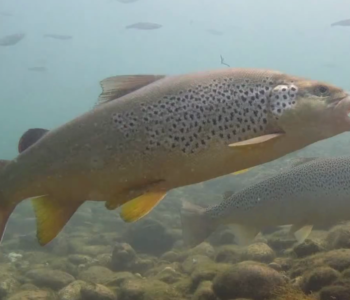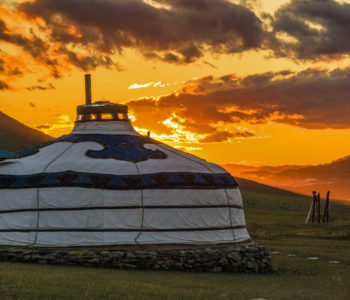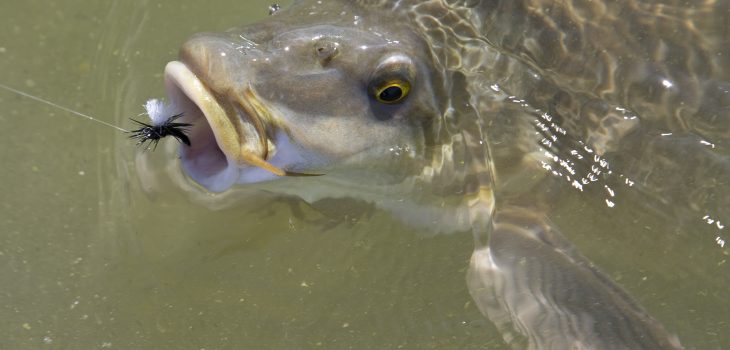
Fly fishing for freshwater bonefish (part 2)
During day three we went back to the lake again where Luis taught me how to catch surface feeding barbel in deeper water about 25-30 meters from the shoreline. To be successful I had to cast a five meter leader straight into the wind. It is not my specialty and I am not really a long distance caster either and I usually let the wind help me to reach my distance. To be successful I had to change a 30 year old leader system to Luis’s much thinner and more fragile system because my homemade braided leader was simply too heavy to cast into the wind. It was a great learning moment and it proved to me again that you are never too old to learn something new.
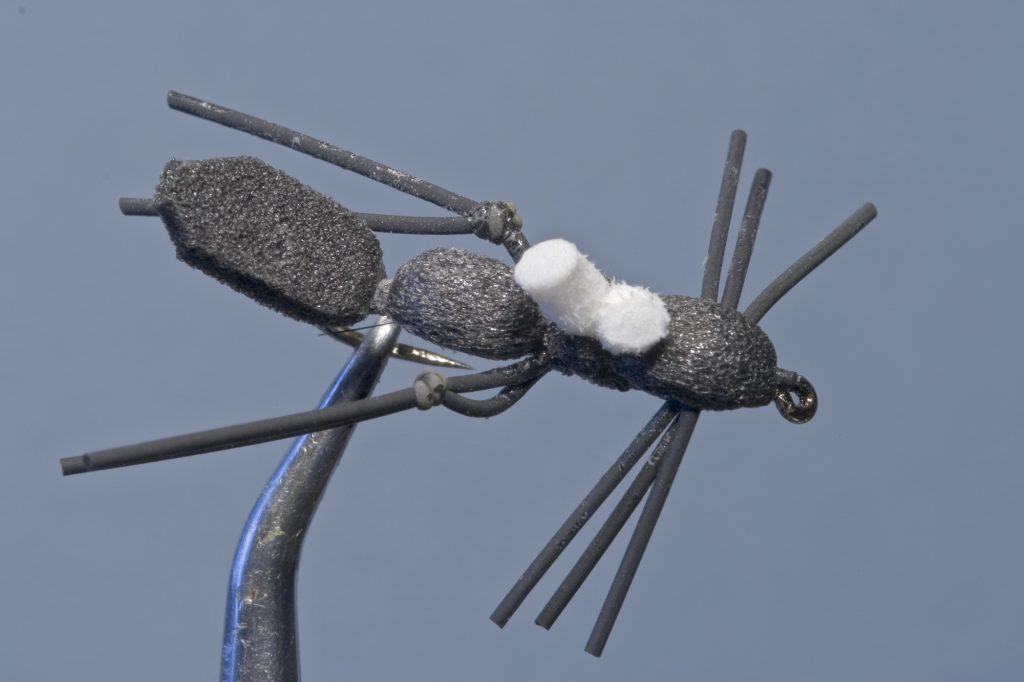
At day four we were dropped at a new spot ideal for shoreline fishing between the rocks and tiny coves. Luis decided to split us up so Carsten and I could practice all the tips and tricks that we learned by ourselves. I chose to fish against the wind after I had become fully convinced that the barbel were feeding much more aggressively and because I caught the largest fish that way. I am sure that Luis put us apart to show us that barbel fishing is most productive when you fish quietly, make long walks and fish on your own and he was right. Of course like a perfect guide does, he checked on us from distance. The place turned out to be the absolute hotspot of the entire week and the surroundings were simply stunning. Because the wind direction didn’t change overnight we both wanted to go back there to enjoy our last day barbel fishing. For me this place gave me an extra dimension when it suddenly turned out that the barbel went completely nuts for my Klinkhåmer Special and provide me one of the best day’s fishing that I ever had with my Klinkhåmer. I probably was at the right place at the right time.
Fishing and techniques
Let me share with you a little of the experience that I was able to gain. I discovered very quickly that when you fish shorelines you can’t fish close to each other because you simply spook the fish for the other person. Once you have fished a stretch or a particular area, it is useless for another person to follow into your footsteps, even at a good distance. If a piece of shore has been fished you have to give it a good long rest and when wind directions are not changing it is even better to return the next day. However there is one exception and that is when there is a nice strong wind with fish feeding not too close to the shore but still within casting range. The wind direction is crucial and we were most successful when fishing directly into the wind. Although my own leader system worked well, long leaders are essential to be successful, especially when casting against the wind. In all circumstances that we faced the barbel were not difficult to spot. Amazing was that even in strong wind and deeper water you can spot them quite easily as long they are cruising in the surface. In that situation you just look for the golden reddish shade better known as the “Red Ghost” as Luis calls his cruising barbel.
During our learning process Carsten and I took a turns while we were walking, searching and casting for the cruising, tailing or finning barbel. Luis constantly provided us with the best advice and tips. Presentation is extremely important and when you see cruising fish you really have to drop your fly right in front of his nose and you often only have just one chance. I love fishing for the cruisers because they could be quite aggressive too. A perfect technique when barbel are tailing, finning or seem not interesting at all, is to try to let your fly really plop in the surface film with a lot of noise and splash. Sometimes it got their attention and they came for it. If your fly ends up too far from the fish’s head you can try to attract them by moving your fly with short pulls or little wakes. You have to experiment a little.

When a barbel takes a dry fly he open his mouth and lifts his head, grabs the fly and put his head down again and what follows is an explosion in the water film. As soon you set the hook, you must let them go exactly like you do with real bonefish. They will run for deep water with incredible speed and if you try to stop them you will break off your tippet or fly right away. Because of this habit of going deep, the fish damage your leader and tippets very quickly, especially in rocky areas and therefore you must check your leader and tippet regularly.
Fishing on the flats is completely different and the fish are clearly less shy, at least that was my experience. With their incredible muscle power they are able to feed in extremely low water, even with their backs fully out. On many occasions that I faced I simply couldn’t believe how they were able to manage to get back to deeper water again. On the flats they also prefer to shoal up more and feed together while you see them hunting more solitary while they following the shoreline. If the flats have a grassy bottom and surroundings and when there are lots of sheep around, the fish seems to hunt extremely close to the shore. It seems that sheep scare the grasshoppers and they often jump in the water where barbel are waiting for them. However, you still have to fish carefully and cleverly because once you spook one barbel on the flats it can take all the others with it back to deeper water again.
Clothing and equipment
Most of the fishing was done from the river bank and shore of the lakes. You don’t need waders but you absolutely will need good shoes for walking and wading. One day I walked and fish for about 10km so sometimes you cover really long distances. I decided just to take my keens and my normal wading shoes for greasy bottoms. The keens worked well on the flats but we found the river completely covered with slippery stones, so I highly recommend wearing thick socks and using wading shoes with minimal studs on them. In general I felt most comfortable with my wading shoes with aluminum bars underneath, even for the long distance shoreline fishing. Long trousers, a shirt with long sleeves and UV protection, a bandana, skin saver gel with minimal SPF30+, Polaroid’s and a good cap are indispensable against the hot sunny conditions. I didn’t take any raingear with me because the weather and forecasts were simply awesome and usual in hot areas; rain is like a hot shower to me. For the shoreline fishing I always had a 1 liter thermos with me that I filled with ice cubes and water and refilled it during lunch again.
After my personal experience a 5- or 6-weight rod between nine and ten feet will be perfect. The fish that we caught were between four to ten pounds. I use a 5-weight rod when the wind was calm and took my 6-weight in more windy conditions.
Due to the amazing runs that barbel can make, the reel should have an excellent drag system with minimal 100-150 meters of reliable backing such as Greenspot. To prevent disappointment you should chose a reel that can handle high speed runs over and over again. Your reel should be carry a floating line that gives you most accuracy. I highly recommend weight forward lines because the fish can be often at very short distance as well. Sometimes you have to land the fly just on the water’s edge because fish can feed up to five centimeters from the shore. I didn’t use any tropical lines and had no difficulties. Clean your lines well during and after fishing especially when you have cast your line on grassy or sandy bottoms and avoid casting into algae. When you have fish in an algae area clean your line as soon as possible!
Leaders are essential as well, and they can vary enormously in length depending on the force of wind and quality of your casting. We used leaders between three and five meters, but under normal circumstances, leaders should measure between three and half and four and half meters. Your tippet should never be thinner than 0.20mm and be aware about the fact that many tippet materials are not very reliable in the diameters as mention on the spools. Luis strongly advises 0.24mm and where possible, fluorocarbon. I tested several brands of monofilament during this trip and was most pleased by using Stroft GMT, Stroft ABR and Stroft FC1, because their reliable diameter, suppleness, knot strength, resistance to abrasion and extremely powerful breaking strain. Carsten used Stroft GMT all the time.
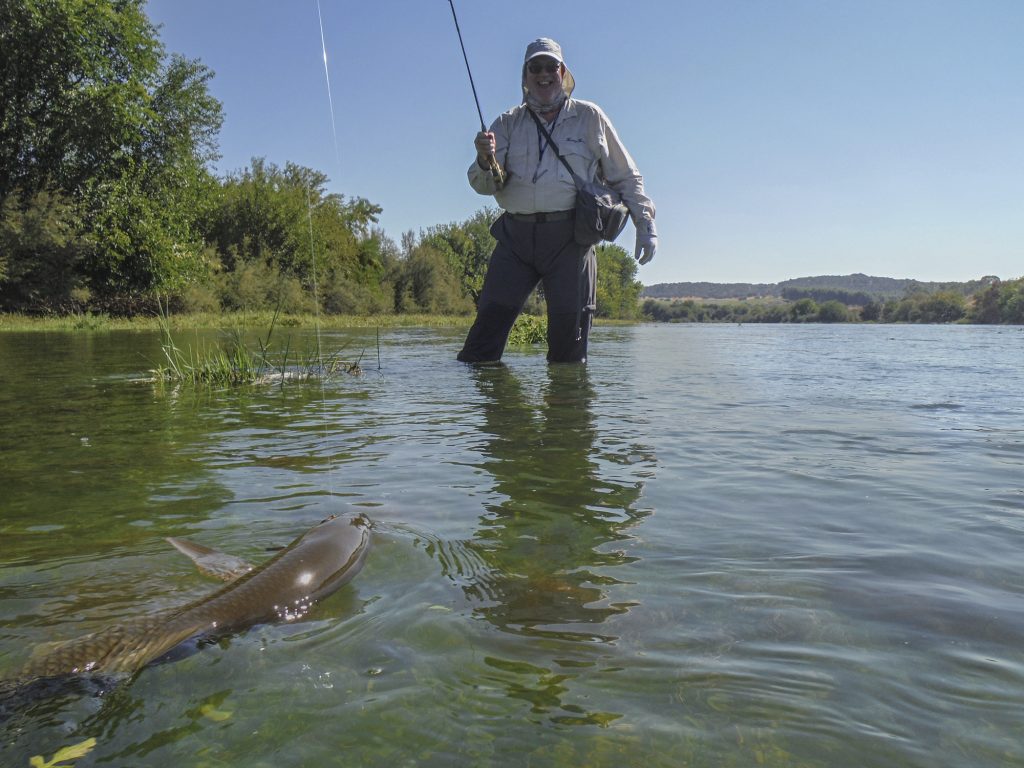
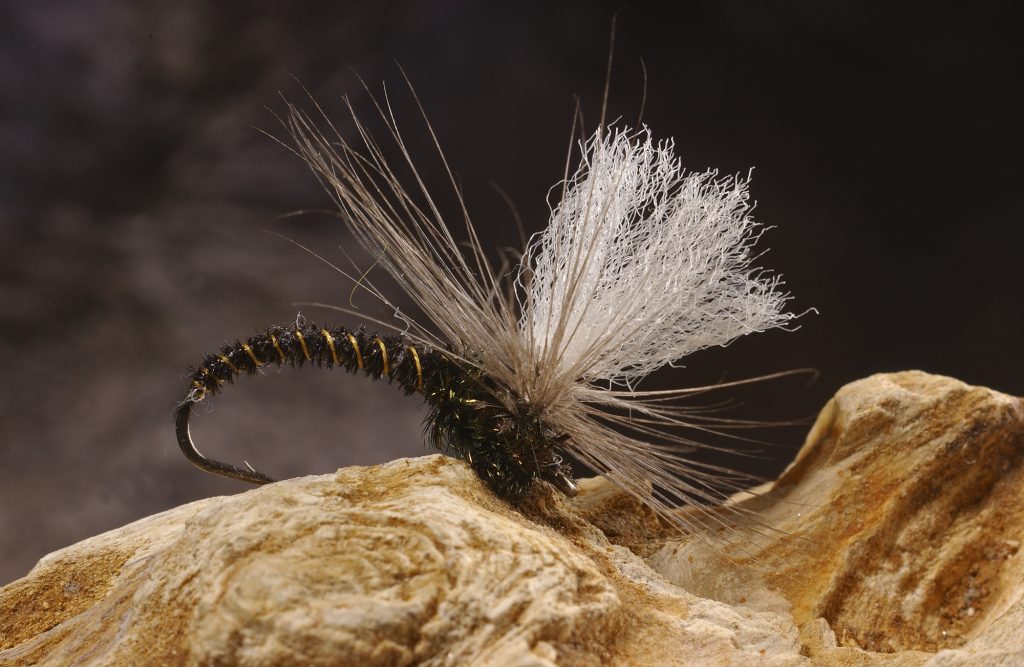
Fishing flies for barbel
For barbel fishing the biggest secret of all is the right fly choice and Luis even claims it as the most difficult issue to settle. There are many dry flies that will work, such as beetles and hoppers, but there is one fly in particular that will out fish all the others. It is proven beyond any doubt. The reason is simple. The areas where Luis learned his barbel fishing have an extremely high population of flying ants. This makes imitations of big ants with wings the best choice by far. For a week’s fishing trip you will need at least 60 ants in sizes 12 and 14. Over the years, Luis designed his own perfect ant imitation and he is very proud on his fly. His best barbel pattern is absolutely stunning; especially because his design is based on visibility because if you can’t see your pattern very clearly you never will be able to set the hook at the right moment. This is why Luis ties all his ants with a nice big white wing of poly yarn. The hooks have to be strong and reliable as well because barbel are masters at bending hooks. I highly recommend Daichii 1170, 1180, 1182, 1190 or 1280. I used patterns that were all tied on these numbers and none of them bend out or broke. My own patterns that I tried with success were the Klinkhåmer Special, my Parachute Ant, and several variations of my Ugly Bugs that I use a lot for ide and grayling fishing. All the flies I tied with an extra piece of white foam or poly yarn to make them more visible and I use sizes 10 and 12. Without this extra indication it is impossible to see the flies in windy conditions or when the surface film is quite restless. A big difference in my ant flies compared with those that Luis ties were the size of the legs that I was using. I did an intensive ant research several years ago and discovered that ants have far longer legs then most people think and that is why most fly tiers are tying the legs often far too short. On some occasions I caught less than Carsten, but overall my sizes of the fish were bigger and I blame it to the much longer legs in my flies that I am using more frequently.
During our five day fishing trip we only used dry flies but I have to admit that I tried nymphs twice for a short moment, just out of interest and to see if I also was able to catch a barbel on nymphs in the river and lake. My original Leadhead pattern was the best fly in Germany for barbel and worked very well in Spain too.
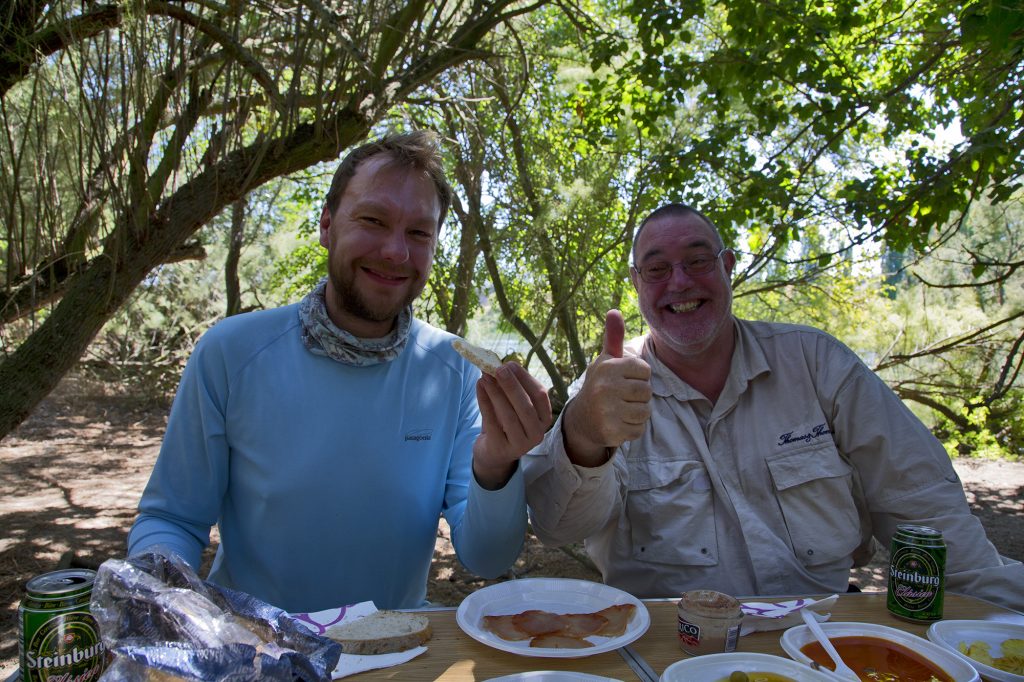
Food
Our breakfasts, shore lunches and dinners were absolutely daily highlights and all the food was based on very special and traditional Spanish gastronomy. For Luis it is very important that his clients taste the Spanish local products, apart from the typical grills. I love cooking myself and one evening our chef allowed me to cook together with her, which was another great moment of my trip.
Final conclusion
Fly fishing for barbel in Spain is absolutely stunning. Once you know the tricks of the trade the catches are most often good and when you really get lucky you’ll catch an eight or ten pounder that leave you with unforgettable memories. I don’t count, measure or weigh my catches, but I guess that I caught at least one 10 pounder during my trip. It was the only fish that took me far beyond the 50 meters of backing marking point. So including that to my 32 meter fly line and five meter leader, it really made for an amazing run. Beautiful runs from 40-50 meter happened often, of course depending on the size of the fish. In rocky areas the fish we caught were much bigger and I saw my backing with almost every fish. We had a perfect time of the year but October is even more spectacular when the ants are in the air in their trillions. Barbel fishing with a dry fly is almost similar to bonefishing indeed. I couldn’t believe it. You fish with dry flies only, in fantastic temperatures while staying in wonderful, high quality rural houses. The prices are low, and the distances to the fishing spots are short. I am certainly going back again next year!
